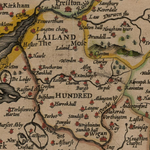Buckshaw Parkway railway station
Northern franchise railway stationsPages with no open date in Infobox stationRailway stations in ChorleyRailway stations in Great Britain opened in 2011Railway stations opened by Network Rail ... and 1 more
Use British English from January 2017

Buckshaw Parkway is a British railway station which opened on 3 October 2011 on the Manchester to Preston Line, near Euxton Junction with the West Coast Main Line. It is one of Euxton's two railway stations being in Buckshaw Village, formerly the Royal Ordnance Factory (ROF Chorley) between Chorley and Leyland. It is close to the site of the four-platform Chorley ROF Halt, which was closed in 1964, remained virtually intact until the 1970s, but was finally cleared in the early 2000s.
Excerpt from the Wikipedia article Buckshaw Parkway railway station (License: CC BY-SA 3.0, Authors, Images).Buckshaw Parkway railway station
Central Avenue,
Geographical coordinates (GPS) Address Nearby Places Show on map
Geographical coordinates (GPS)
| Latitude | Longitude |
|---|---|
| N 53.674 ° | E -2.663 ° |
Address
Central Avenue
PR7 6DS , Euxton
England, United Kingdom
Open on Google Maps







